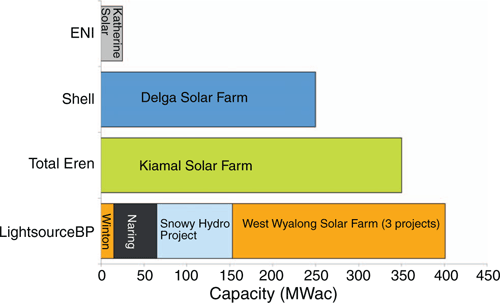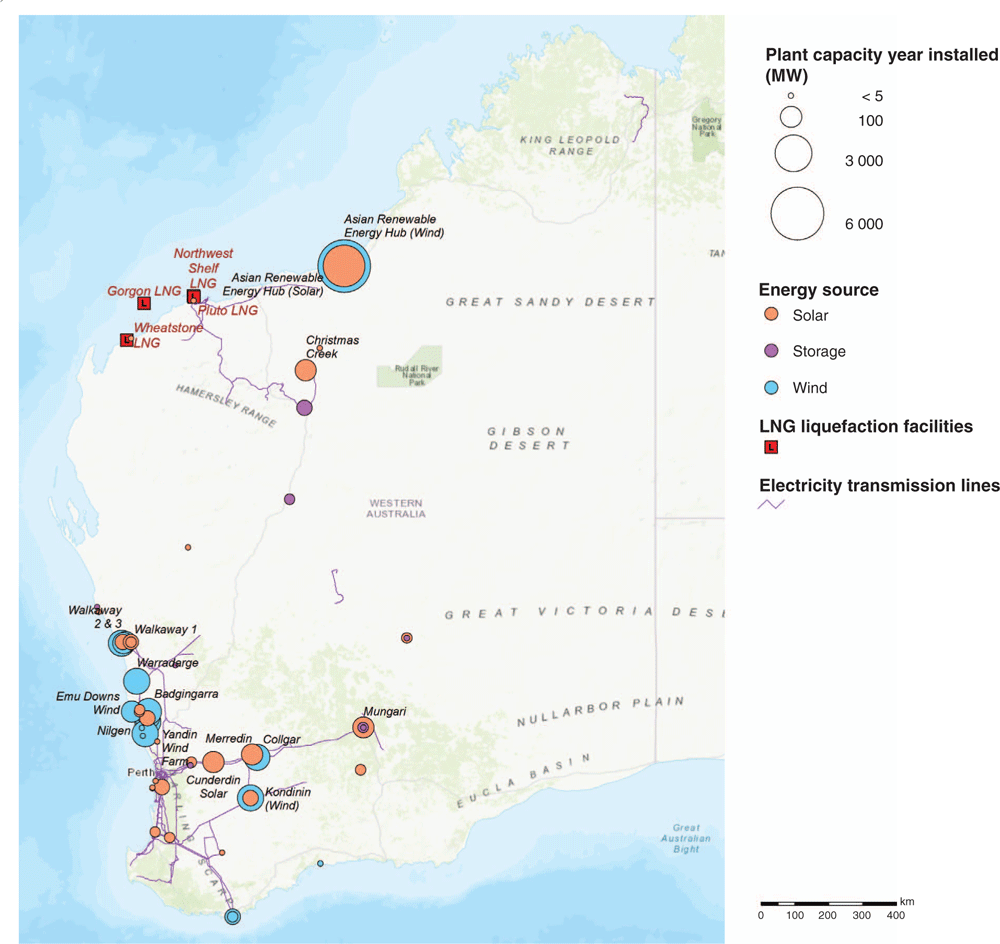Renewed energy in Asia’s upstream
Gero Farruggio A B and David Dixon AA Rystad Energy, Level 24 Three International Towers, Barangaroo, NSW 2000, Australia.
B Corresponding author. Email: gero@rystadenergy.com
The APPEA Journal 59(2) 582-585 https://doi.org/10.1071/AJ18193
Accepted: 28 March 2019 Published: 17 June 2019
Abstract
Upstream is enjoying a renewed optimism in pricing and project developments, and the growth outlook is positive. That said, current investment in upstream across Asia is less than half that of renewable projects, which accounted for over US $180 billion in 2018. Got your attention? It certainly has for national oil companies and regional oil and gas players as companies explore the opportunities presented by lowering solar and storage costs. In this paper we analyse capex trends and forecasts across both sectors in Australia and the region. Will this growth continue, who is set to gain and by how much? We explore the growing role of renewables in the oilfield service sector. Australia is not alone in experiencing a renewables boom; the trend continues across Asia, with government initiatives more often than not being the catalyst and the boom then fuelled by a seemingly endless supply of insatiable investors. Australia is experiencing a frenzy of activity; developers are rushing to grab land and be the first past the post on grid connection. What can we expect as the renewable energy target transitions to the national energy guarantee, to whatever comes next? We compare the corporate landscapes across the upstream and new energy sectors, and explore what is driving them closer each year as miners and upstream operators turn to solar, wind and storage to reduce operational expenditure and boost field economics. Adani has one of the largest solar pipelines in Australia; will Woodside follow suit? Finally, we compare returns for recently commissioned renewable and upstream projects.
Keywords: APAC, Asia Pacific, Australia, renewables, solar, utility storage, wind.
Introduction
The Australian renewable energy pipeline is growing at unprecedented levels. Investment is currently matching upstream capex, at US$10 billion per annum. At the time of writing, over 100 GW of solar, wind and utility storage projects are in the pipeline. Only 1 GW is currently owned by upstream companies, the majors.
By the end of the decade it is feasible that the majors will be the dominant renewable developers in country and regionally. The driver will be economics as much as an increasing desire to ride the ‘solar-coaster’.
Renewables in upstream
Australia’s renewables sector
Australia’s renewables pipeline exceeds 100 GW (Rystad 2019a), over double the national electricity market (NEM). Only 10% of these projects are currently operating, with a further 5% expected to come online in 2019. Over 800 MW of large-scale Australian solar was commissioned in 2018, only 4 years after the first wave of utility solar farms broke ground here (Rystad 2019b).
The growth outlook is strong, buoyed by a pipeline of new projects growing at a rate of over 2 GW per month in 2018. The first two months of 2019 saw activity increase to over 3 GW per month (Rystad 2019b), with over 50% of companies being new entrants to the Australian market.
Much of the renewables pipeline (over 31 GW, or one-third) is stalled at the development approval (DA) stage, curtailed by grid connection and merchant risk (Rystad 2019a). Winners have offtake and either grid access or distributed generation. Corporate power purchase agreements (PPAs) are driving activity rather than policy, a trend that is likely to continue, presenting numerous cost-saving and commercial opportunities for upstream and energy intensive players.
Renewables and upstream: the current state of play
Eni was the most recent upstream player to enter the Australian market, acquiring the Katherine solar project. A relatively small project at a national level, but significant for the Northern Territory, the Katherine solar project has secured a PPA and is due to start construction in 2019. LightsourceBP has the largest (E&P player) portfolio in Australia with over 410 MWac from six projects (Fig. 1). Shell is unique in that it is the only developer to use the generated power, whereas others have struck third-party agreements to sell to offtakers.

|
Woodside and Santos are absent from the chart (for now), but both are making strides in the sector. Woodside to date has focused on battery storage replacing spinning reserves. Santos is pioneering on two fronts: replacing oil-driven generators on beam pumps and behind-the-meter large scale photovoltaic (PV) systems. The Hobbes-1 beam pump is unique in that it is the first off-grid solution in this application. Electrification of beam pumps is common in the US, but these are grid connected. The 16-kW pilot project was developed by AGL, using Q Cell panels, Ecoult battery and 5B prefabricated racking. Santos identified over 300 further sites across the Cooper Basin with a view to eliminating infield gas use, which currently accounts for 15% of production. High east coast gas prices are the driver here, capitalising on falling solar and storage costs.
Santos is also pursuing large-scale solutions through a joint venture with ZEN Energy. It has already sanctioned a 2-MW behind-the-meter solar PV development at its Port Bonython facility in South Australia. The facility is grid connected and uses electricity within its operations; the solar farm reduces both exposure to electricity prices and Scope 2 (indirect energy) emissions.
East coast gas can ill afford to be used infield at current prices. The commercial drivers for alternative solutions intensify with higher gas prices and increasing PV market competition driving down project breakevens.
Where next for the majors?
Is it feasible that the majors will soon dominate solar, wind and storage in Australia and regionally? We focus on factors that can deliver this: utility solar, storage and offshore wind (Fig. 2).

|
Mega projects aside (e.g. the Asian Renewables Hub and Walcha), Australia’s renewables majors include the likes of CWP Renewables, RES Group, Neoen, Pacific Hydro and Tilt Renewables. All have developed large portfolios over the years, benefiting from the renewable energy target, state-driven schemes and corporate PPAs.
Energy-intensive users like Adani and GFG Alliance are emerging players in the solar pipeline. Upstream facilities will follow and at pace and scale.
In Australia, 2018 was significant because we saw the first solar PPAs undercut wind power in Australia, and this year was also the first when more Australian utility solar (800 MWac) was installed than wind (620 MWac). The breakeven cost of utility-scale solar continues to fall with panel pricing and increasing competition in the solar EPC space. Coupled with the falling cost of lithium batteries, upstream is waking up to the potential cost saving on power. Liquefied natural gas (LNG) facilities consume between 7% and 10% feed gas. Offsetting some or all of this would either open the opportunity of realising LNG export revenue or reduce the capital development feed costs.
Over 2.4 GW of utility storage projects were added to the Australian pipeline in the first 2 months of 2019; this is almost half the total amount of storage added (5.6 GW) in 2018. Utility storage is here (no longer a future development) and gas turbines purely running for redundancy are a thing of the past, or redundant, for use of a better word! Woodside is leading the charge, installing a battery on the North West Shelf Goodwyn offshore platform to eliminate spinning reserve. Woodside (2018) estimates a 5% reduction in CO2 emissions from the battery deployment alone.
Offshore wind is nothing new. First developed over 30 years ago in Denmark using 450-kW turbines with a blade diameter of 30 m, today’s turbines are reaching 12 MW with a blade diameter of 220 m. The technology requires capital and offshore expertise, which appeals to upstream players. Turbines can be produced and rolled out at scale, driving down costs at rates seen in PV and lithium ion batteries. The ‘land’ grab has started to secure the best wind resource in deeper waters for when costs reduce to the levels seen onshore today. We expect offshore wind to account for 20 GW of capacity in APAC over the next 5 years. Australia will not be left behind; with a mature offshore service capability, it is well positioned to support this opportunity here and regionally.
Summary and conclusion
The Australian renewable energy pipeline is growing at unprecedented levels, attracting increasing numbers of global renewables players. Upstream companies will grow from 1% of the pipeline to lead the charge, building sizeable utility storage, solar and (ultimately) offshore wind portfolios. Solar panels, lithium ion batteries and turbines will soon be conventional segments of Australia’s oilfield services.
Conflict of interest
The authors have no conflicts of interest.
Acknowledgement
This work was undertaken as part of Rystad Energy’s research practice.
References
Rystad (2019a). ‘Australia: A Big 2018, a Bigger 2019, an Uncertain 2020.’ (Renewable Energy Analytics, Rystad Energy: Sydney, NSW.)Rystad (2019b). ‘Renewable Tracker News and Revisions.’ (Renewable Energy Analytics, Rystad Energy: Sydney, NSW.)
Woodside (2018) World-first offshore battery. Avialable at: https://www.woodside.com.au/news-and-media/stories/story/world-first-offshore-battery [verified 24 April 2019]

Gero Farruggio joined Rystad in November 2017 and is responsible for the overall business in Australia and Rystad’s global renewable energy offerings. Gero brings over 20 years of industry and community service experience, including directorship, senior management, consulting and advisory roles. Gero is Head of Rystad Australia and the cofounder of Sustainable Energy Research Analytics – A Rystad Energy Company, based in Sydney. Gero is a member of the editorial board for Ecogeneration magazine, a member of the Australian Institute of Company Directors and a mentor for EnergyLab, the Sydney-based clean energy accelerator. Gero started his career at Schlumberger, where he demonstrated the commercial value of geosteering technology in Venezuela and Nigeria, publishing a selection of papers on innovations for the optimisation of horizontal oil wells. Gero then spent 16 years at Wood Mackenzie, as Director of Wood Mackenzie Australia Pty Ltd and responsible for Americas and APAC Upstream research. In November 2017, Rystad Energy acquired Sustainable Energy Research Analytics (SERA), where Gero was Managing Director specialising in renewable energy research and advisory. Gero graduated in mechanical engineering (MEng, ACGI) from Imperial College London and has an MBA from Edinburgh University. |

David Dixon has an undergraduate degree in Petroleum Engineering, with a Masters of Photovoltaic Engineering from the University of New South Wales. David has 6 years’ experience in the energy (upstream and solar) industry, with Shell, Woodside and Solgen Energy. David’s roles have included production technologist at Shell working on the development of the Prelude and Concerto wells supplying gas to Prelude’s floating LNG, completions engineer on key Australian oil and gas projects, including Browse, Enfield and Pluto, and engineer at Solgen working on commercial solar. David works as a renewables analyst covering the Australian Market and is based in Rystad’s Sydney office. |


